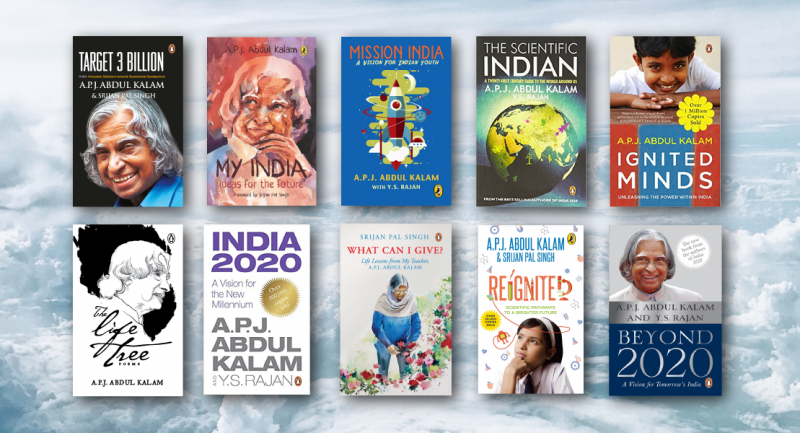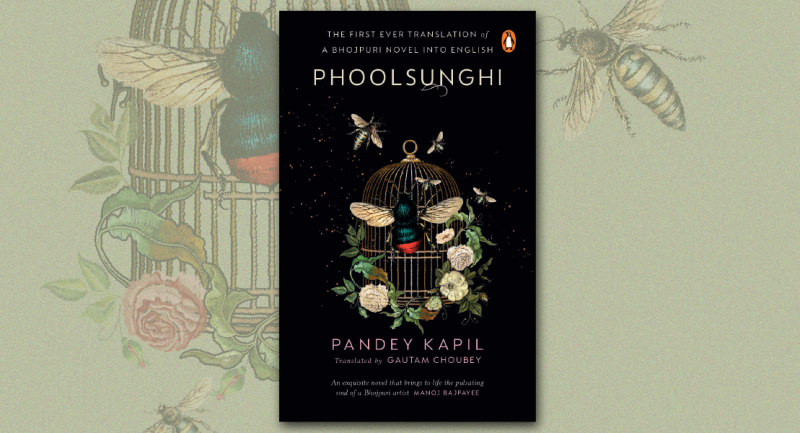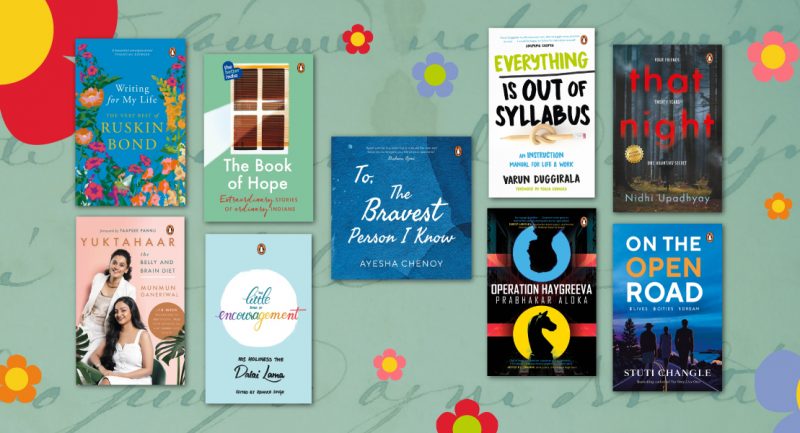
Namita Gokhale is an award-winning writer and festival director. She is the author of eleven works of fiction and has written extensively on myth as well as the Himalayan region. Her acclaimed debut novel, Paro: Dreams of Passion, was published in 1984. She is committed to supporting translations and curating literary dialogues across languages and cultures. She is also co-founder and co-director of the vibrant and world-famous Jaipur Literature Festival. Here you’ll find a list of unmissable books by Namita Gokhale:

Part ghost story, part erotic romance, The Book of Shadows is an ambitious book that investigates the nature of reality, love and faith. It is a work of startling originality by one of India’s most daring and talented writers.

‘Before mother left, in a long-ago time, we had been very rich. My grandmother had been a great singer, a kothewali whose voice was more liquid and beautiful than Lata Mangeshkar’s. Eleven nawabs and two Englishmen were besotted with love of her.’ From these great heights Gudiya’s world plunges into the depths of almost complete penury when she arrives in Delhi with her ancient grandmother, Ammi, fleeing small-town scandal and disgrace. Just when all seems lost, Ammi works a miracle: a slab of green marble stolen from a building site, and five rounded pebbles from a sahib’s garden, are transformed by the power of her singing voice into an inviolable place of worship. From here on, Gudiya’s life takes on an extraordinary momentum of its own. Ammi dies a small-time saint, Pandit Kailash Nath Shastri predicts a future of impossible luck, the irrepressible Phoolwati becomes an unlikely guardian, and the inhumanly handsome Kalki rides in on his white horse and steals her heart. As we follow the twists and turns of Gudiya’s story, we see unfold before us the peculiar dance of chance and will that is human existence.

With this haunting novel about romantic loss and fatalism, Namita Gokhale confirms her reputation as one of PBI – India’s finest writers, and one with the rare gift of seeing and recording the epic in ordinary lives. This is the story of Parvati, young, beautiful and doomed, and Mukul Nainwal, the local boy made good who returns to the Nainital of his youth to search for the only woman he has ever loved. Told in the voices of these two exiles from life, this spare, sensitive book is a compelling read.

On the ghats of Kashi, the most ancient of cities, a woman confronts memories that have pursued her through birth and rebirth. In the life she recalls, she Shakuntala of the northern mountains-spirited, imaginative, but destined like her legendary namesake to suffer ‘the samskaras of abandonment’. Stifled by social custom, hungry for experience, she deserts home and family for the company of a Greek horse merchant she meets by the Ganga. Together, they travel far and wide and surrender to unbridled pleasure, as Shakuntala assumes the identity of Yaduri, the fallen woman. But an old restlessness compels her to forsake this life as well-and court tragedy.

In Search of Sita presents essays, conversations and commentaries that explore different aspects of her life. It revisits mythology, reopening the debate on her birth, her days in exile, her abduction, the test by fire, the birth of her sons and, finally, her return to the earth-offering fresh interpretations of this enigmatic figure and her indelible impact on our everyday lives.

India is shining, and Suresh Kaushal, the stout lawyer -of sober habits’, has propelled himself up the political ladder to become Minister of State for Food Processing, Animal Husbandry, Fisheries and Canneries. His wife Priya can’t believe their luck and, determined to ensure it doesn’t run out, struggles valiantly with -social vertigo’, infidelity and menopause. Along the way she also learns vital lessons on survival, as she watches her glamorous new friend Pooonam chase status, sex and Jimmy Choo shoes, and her radical old friend Lenin ride a donkey and lose his bearings. In this wickedly funny, occasionally tender, book, Namita Gokhale resurrects some unforgettable characters from her 1984 cult bestseller Paro, and plunges them neck-deep into Delhi’s toxic waste of power, money and greed.

Paro is a heroic temptress, alluring and rapacious, the stuff of legend. Wandering through the world of privilege and Scotch whiskey that the rich inhabit, she is observed constantly by the acid Priya, eternal voyeur and diarist, who identifies strongly with the heroine of her favourite novel, Rebecca, and vicariously follows the melodrama of Paro’s life. Priya herself is in love with her boss, the irresistible BR, sewing-machine magnate and ‘the Housewife’s Friend’. Paro, inevitably, marries him, to Priya’s fury. But BR is merely one among a whole string of admirers; Paro has seduced many. Eventually, as in all moral tales, Paro succumbs to life and circumstances, but not before the reader has been wildly entertained by social comedy without parallel in Indian writing.

The Habit of Love is a collection of stories about the inner lives of women. Some of these women inhabit the ancient past, some the present day but they share the whimsical humour with which they speak of themselves. Delicately poised between irony and grief, The Habit of Love is both elegant and acute, arch and melancholic. In these moving stories she displays both sympathy and understanding as she unveils the workings of a woman’s heart.

Shiva: Destroyer and Protector, Supreme Ascetic and Lord of the Universe. He is Ardhanarishwara, half-man and half-woman; he is Neelakantha, who drank poison to save the three PBI – Worlds—and yet, when crazed with grief at the death of Sati, set about destroying them. Shiva holds within him the answers to some of the greatest dilemmas that have perplexed mankind. Who is Shiva? Why does he roam the PBI – World as a naked ascetic covered with ash? What was the tandava? What is the story behind the worship of the linga and what vision of the PBI – World does it signify? Namita Gokhale examines these questions and many others that lie within the myriad of stories about Shiva. Even as she unravels his complexities, she finds a philosophy and PBI – Worldview that is terrifying and yet life affirming—an outlook that is, to many, the essence of PBI – Indian thought.

Who was Radha, and why has she captured the imagination of so many writers across centuries? No other goddess combines the elements of bhakti and shringara quite as exquisitely as the divine milkmaid. She spans a vivid rainbow of imagery-from the playfulness of the Ras Lila to the soulfulness of her undying love, from the mystic allure of her depictions in poetry, art and sculpture to her enduring legacy in Vrindavan. In a way that sets her apart from other female consorts, Radha is idealized and dreamed of in a way that is almost more elemental than mythical. Namita Gokhale and Malashri Lal, who brought us In Search of Sita: Revisiting Mythology, now present an anthology on the mysterious Radha, the epitome of love, who defies all conventional codes yet transcends social prohibitions through the power of the spiritual and the sensual, the sacred and the erotic. Finding Radha is the first of its kind: a collection of poetry, prose and translation that enter the historical as well as the artistic dimensions of the eternal romance of Radha and Krishna.

Magnificent gin-drinker Paro, heroic temptress, glides like an exotic bird of prey through the world of the rich in Bombay and Delhi. She lives life recklessly, caring about nothing and nobody. Not even Priya, eternal voyeur and diarist, who views this femme fatale with wonder, trepidation and jealousy until she comes into her own. Two unforgettable women bring a glittering, toxic world of power, money and greed to life, with the scandalous cult classic Paro: Dreams of Passion. Priya: Take Two continues this ride through a world best viewed through a glass of Scotch, as Priya battles social vertigo and learns lessons in survival on her spirited journey to the top.
Published in 1984 and 2011 respectively, Paro and Priya remain incisive and witty commentaries on the movers and shakers of the business and power capitals, invoking all the contradictions of urban India. Namita Gokhale’s pioneering debut and its sequel span a generation and an era, moving from the eighties to the post-millennial Indian society. Wicked, hilarious and utterly amusing, with echoes of Dorothy Parker ringing through their vigorous prose, for the first time the two novels come together in one classic volume, taking the liberated, brazen and all-too human Paro and her natural counterpart, the more timorous Priya, to new readers and old.

Kumaon, 1856. History has already begun its steady march. Six native women clad in black and scarlet pichauras huddle around Naineetal Lake, attempting to cleanse it of ominous influences. These are the days of Upper Mall Road (for Europeans and their horses) and Lower Mall Road (‘for dogs, servants and other Indians’). Amidst a theatre of British impunity, feisty young Tilottama Dutt, whose uncle is hung when he protests the reigning order, and her daughter, Deoki, confront change as Indians and as women.
Winner of the Sahitya Akademi Award for 2021, Things to Leave Behind brings alive the romance of the mixed legacy of the British-Indian past. Full of the fascinating backstory of Naineetal and its unwilling entry into Indian history, throwing a shining light on the elemental confusion of caste, creed and culture, illuminated with painstaking detail, here is a fascinating historical epic and Namita Gokhale’s most ambitious novel yet.

Young Chintamani Dev Gupta, on holiday in a bird camp near Lake Sattal, is transported via a wormhole to the days of the Mahabharata. Trapped in time, he meets Ghatotkacha and his mother, the demoness Hidimba. But the gentle giant, a master of illusion and mind-boggling rakshasa technology, wields his strength just as well as he knows the age-old secrets of the forest and the elemental forces. And in his enlightening company, Chintamani finds himself in the thick of the events of the most enduring Indian epic.
An intense yet tender look at a rare friendship as well as the abiding puzzles of the past, this is a fascinating read.

From a septuagenarian who has completed her semi-fictional novel but does not want to publish it, to an author who receives a threat in the form of an anonymous letter, from a historian who reunites with a past lover, to a burglar who is passionate about poetry, from a young woman who has no idea what this world has in store for her, to an American woman looking for the India of her hippie youth, this metafictional, wryly funny, pacey novel is an ode to literature. Told from multiple perspectives, set against the backdrop of the vibrant multilingual Jaipur Literature Festival, diverse stories of lost love and regret, self-doubt, and new beginnings come together in a narrative that is as varied as India itself.
Partly a love letter to the greatest literary show on earth, partly a satire about the glittery set that throngs this literary venue year on year, and partly an ode to the millions of aspiring writers who wander the earth with unsubmitted manuscripts in their bags, Jaipur Journals is a light-footed romp that showcases in full form Gokhale’s unsparing eye for the pretensions and the pathos of that loneliest tribe of them all: the writers.

The blind matriarch, Matangi-Ma, lives on the topmost floor of an old house with many stories. From her eyrie, she hovers unseeingly over the lives of her family. Her long-time companion Lali is her emissary to the world. Her three children are by turn overprotective and dismissive of her. Her grandchildren are coming to terms with old secrets and growing pains. Life goes on this way until one day the world comes to a standstill-and they all begin to look inward.
This assured novel records the different registers in the complex inner life of an extended family. Like the nation itself, the strict hierarchy of the joint-family home can be dysfunctional, and yet it is this home that often provides unexpected relief and succour to the vulnerable within its walls.
As certainties dissolve, endings lead to new beginnings. Structured with the warp of memory and the weft of conjoined lives, the narrative follows middle India, even as it records the struggles for individual growth, with successive generations trying to break out of the stranglehold of the all-encompassing Indian family.
Ebbing and flowing like the waves of a pandemic, the novel is a clear-eyed chronicle of the tragedies of India’s encounter with the Coronavirus, the cynicism and despair that accompanied it, and the resilience and strength of the human spirit.









